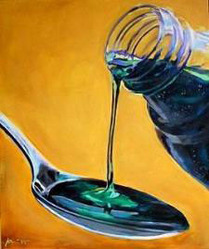
Because the art of herbal medicine is a lost art in many countries, most people don’t know how to prepare and administer herbs. The only way most people take herbs these days is by taking them in pill or capsule form, courtesy of a supplement they bought at a health food or drug store.
But the potency of an herb in pill or capsule form is not strong. To get the true healing benefits of an herb, it’s best to start with the herb in whole form and make a preparation from that.
There are many forms in which herbs can be administered. Here is a list of some of the most common ways:
Tinctures – Alcoholic extracts of herbs such as echinacea extract. Usually obtained by combining 100%
Herbal wine and elixirs – These are alcoholic extract of herbs; usually with an ethanol percentage of 12-38%. Herbal wine is a maceration of herbs in wine, while an elixir is a maceration of herbs in spirits (e.g., vodka, grappa, etc.)
Tisanes – Hot water extracts of herbs, such as chamomile.
Decoctions – Long-term boiled extract of usually roots or bark.
Macerates – Cold infusion of plants with high mucilage-content as sage, thyme, etc. Plants are chopped and added to cold water. They are then left to stand for 7 to 12 hours (depending on herb used). For most macerates 10 hours is used.
Vinegars – Prepared at the same way as tinctures, except using a solution of acetic acid as the solvent.
Topicals:
1) Essential oils – Application of essential oil extracts, usually diluted
in a carrier oil (many essential oils can burn the skin or are simply
too high dose used straight – diluting in olive oil or another food
grade oil can allow these to be used safely as a topical).
made into salves, creams, lotions, or simply used as an oil for
topical application. Any massage oils, antibacterial salves and
wound healing compounds are made this way.
3) Poultices and compresses – One can also make a poultice or compress using whole herbs (or the appropriate part of the plant) usually crushed or dried and re-hydrated with a small amount of water and then applied directly in a bandage, cloth or just as is.
Whole herb consumption – This can occur in either dried form (herbal powder), or fresh juice (fresh leaves and other plant parts). Just as Hippocrates said “Let food be thy medicine,” it has become clear that eating vegetables also easily fits within this category of getting health through consumables (besides medicinal herbs). All of the vitamins, minerals and antioxidants are phytochemicals that we are accessing through our diet.
There are clearly some whole herbs consumed that are more powerful than others. Shiitake mushrooms boost the immune system and are also tasty, and they are enjoyed in soups or other food preparations for the cold and flu season. Alfalfa is also considered a health food. Garlic lowers cholesterol, improves blood flow, fights bacteria, viruses and yeast.
Syrups – Extracts of herbs made with syrup or honey. Sixty-five parts of sugar are mixed with 35 parts of water and herb. The whole is then boiled and macerated for three weeks.
Extracts – Includes liquid extracts, dry extracts and nebulisates. Liquid extracts are liquids with a lower ethanol percentage than tinctures. They can (and are usually) made by vacuum distilling tinctures. Dry extracts are extracts of plant material which are evaporated into a dry mass. They can then be further refined to a capsule or tablet. A nebulisate is a dry extract created by freeze-drying.
Inhalation as in aromatherapy can be used as a mood changing treatment to fight a sinus infection or cough, or to cleanse the skin on a deeper level (steam rather than direct inhalation here).
I have a new free six-day email course that I am offering, entitled Enlightened Living: 6 Ways to Build an Authentic, Serene and Healthy Life. Read more about it here: The Enlightened Living Course or you can just sign up below to receive the course.
[gravityform id=”2″ title=”true” description=”true”]
